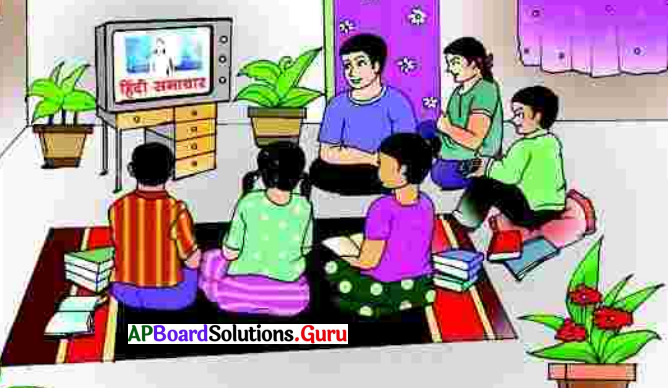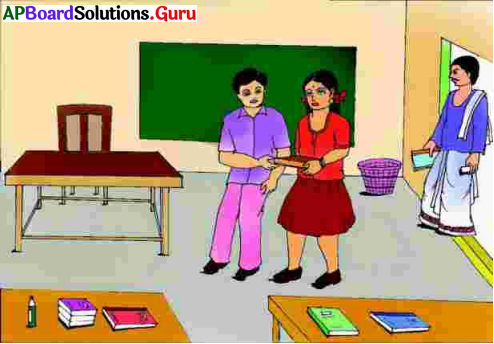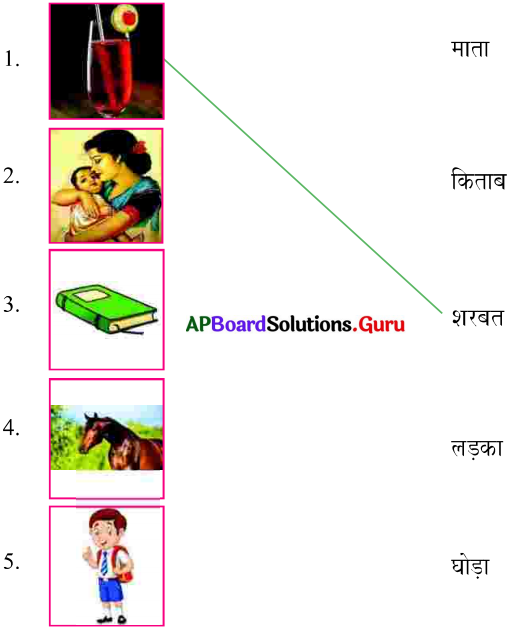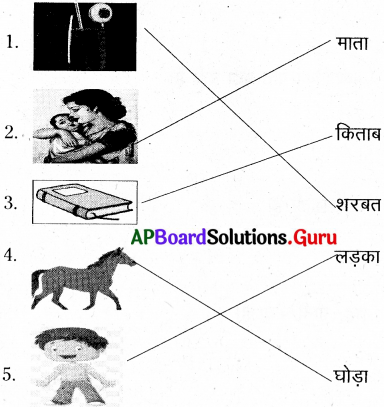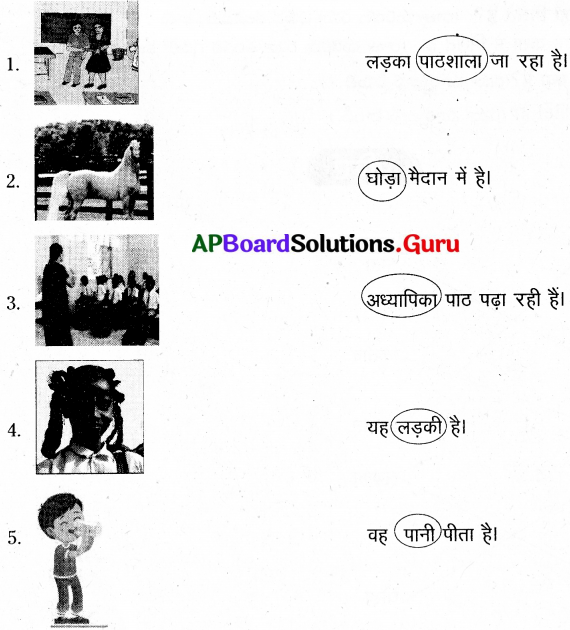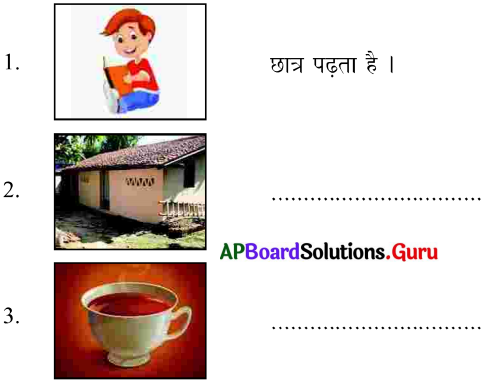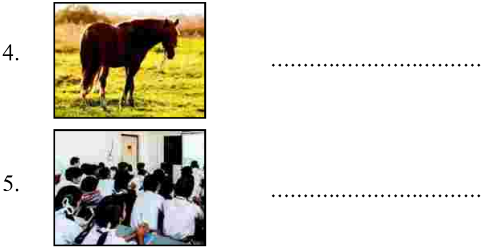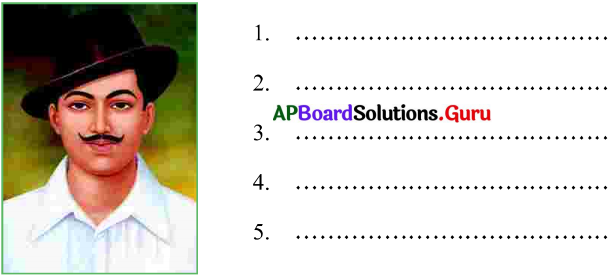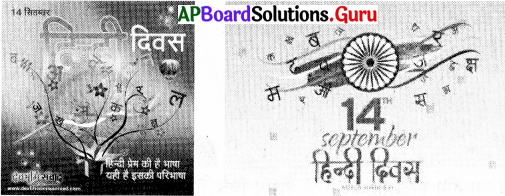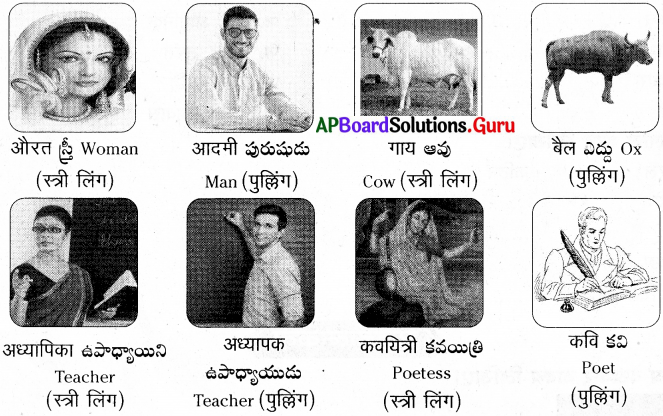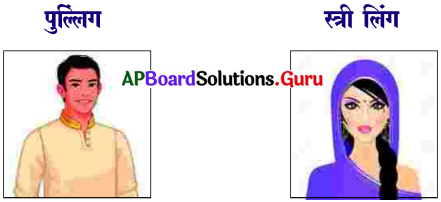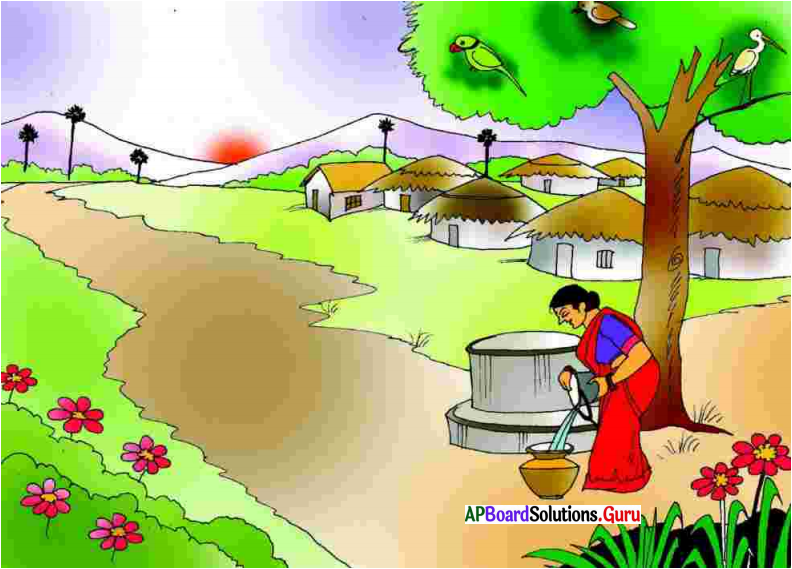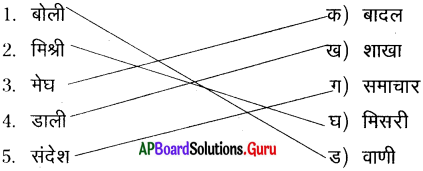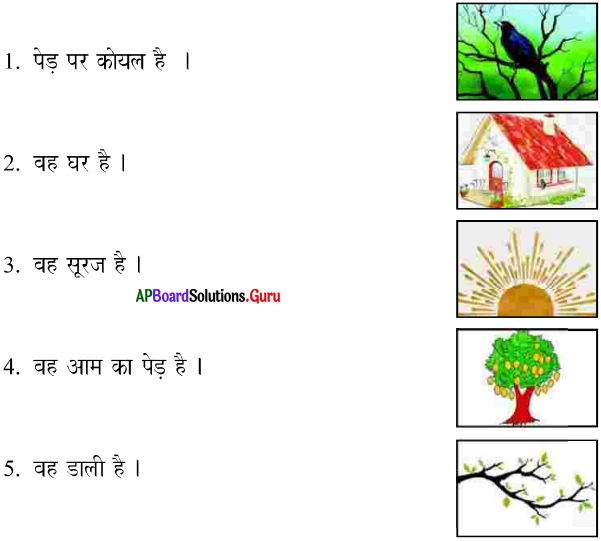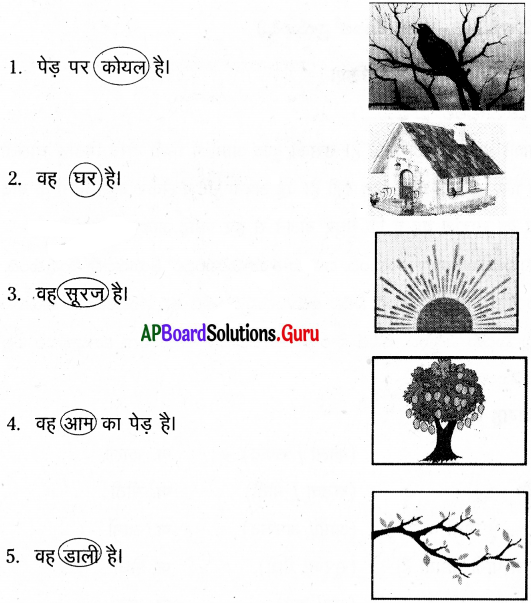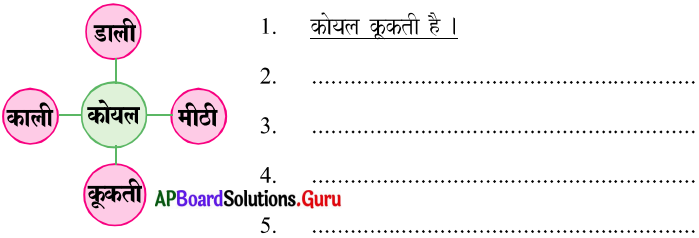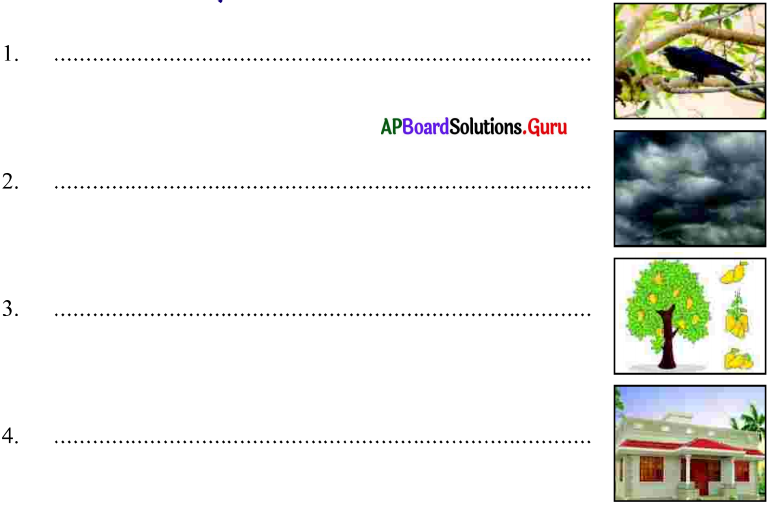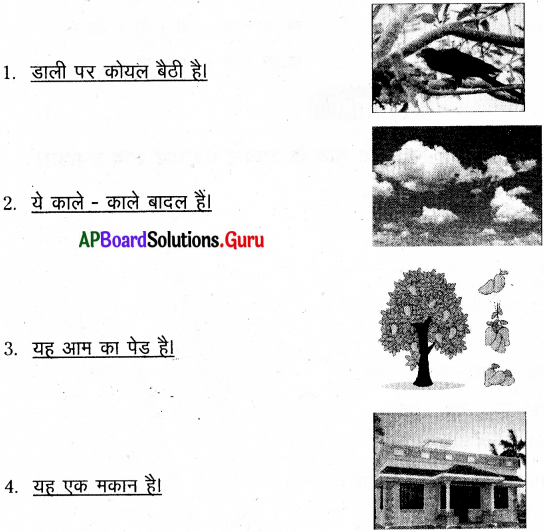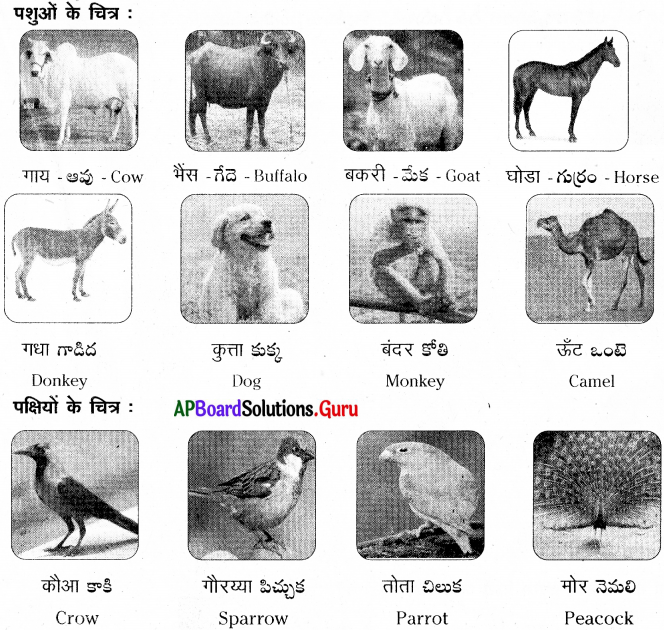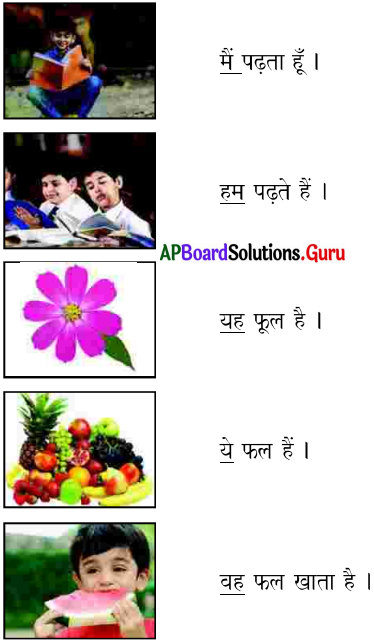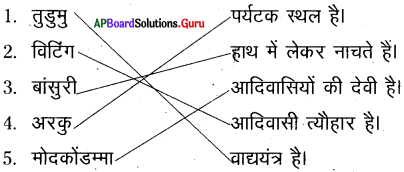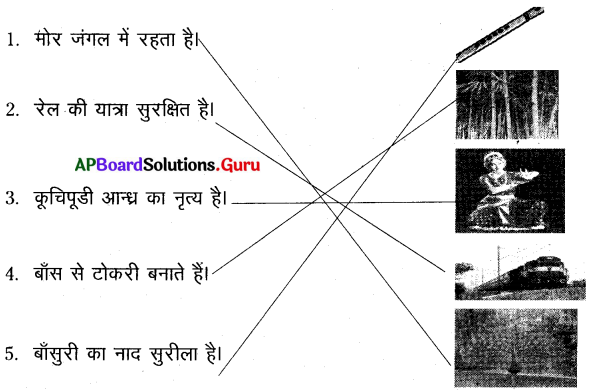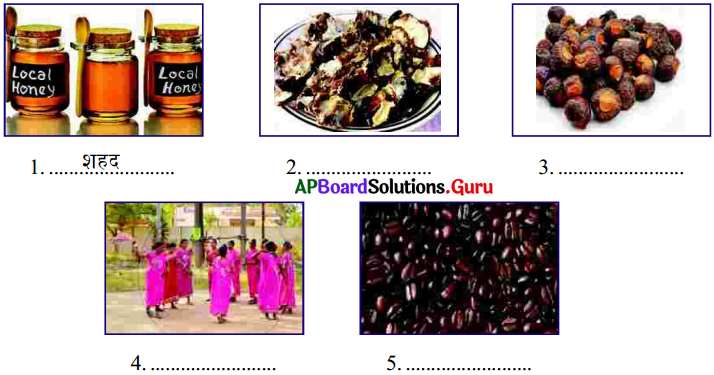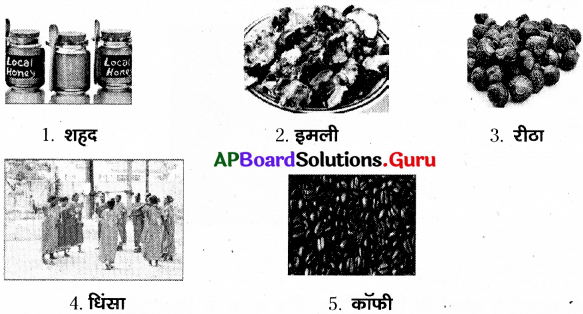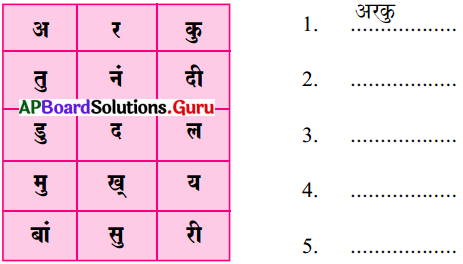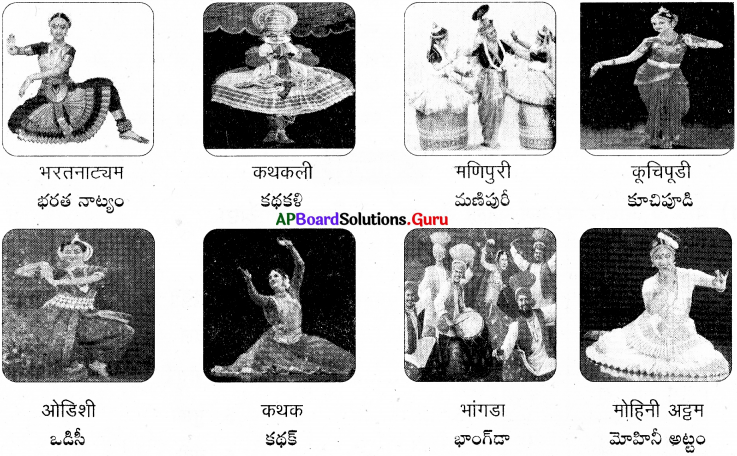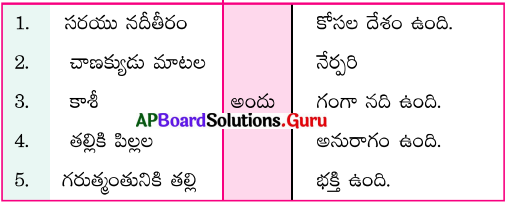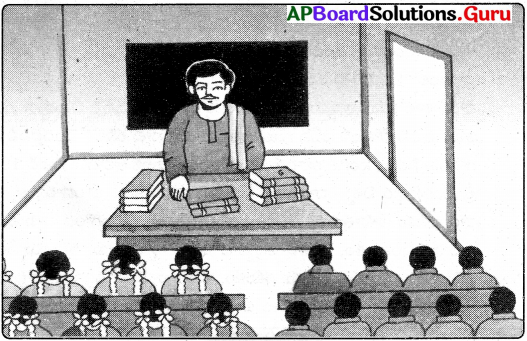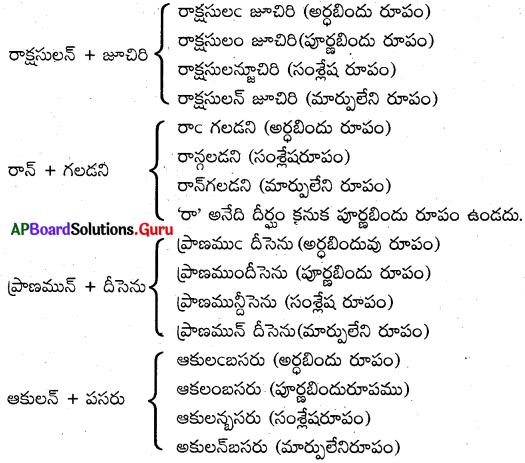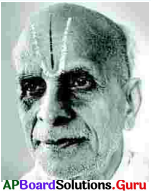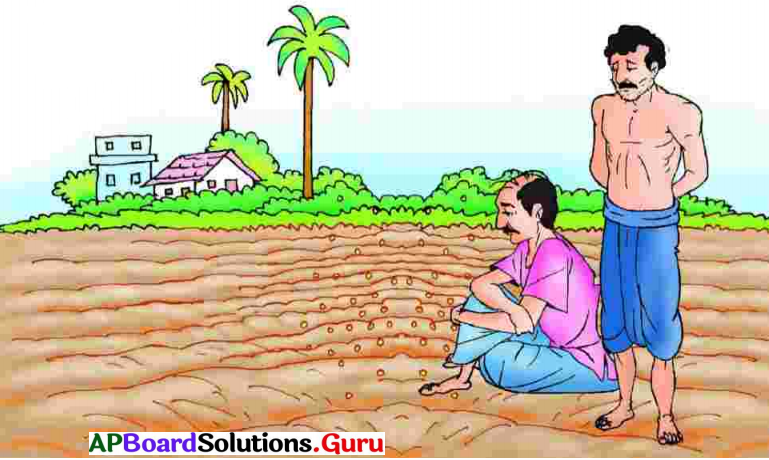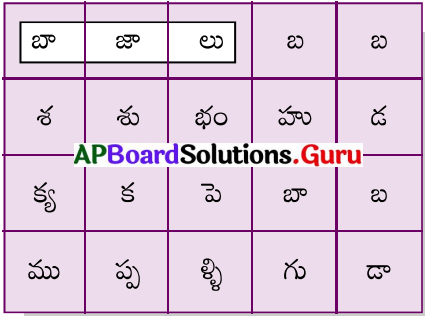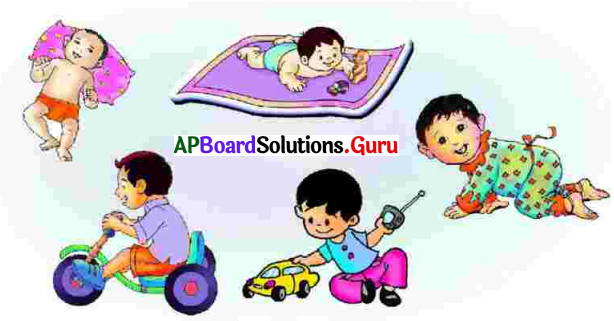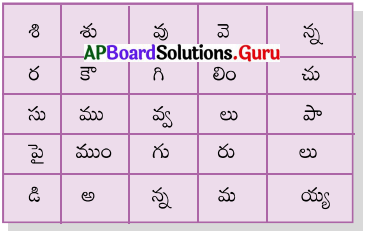SCERT AP Board 7th Class Hindi Solutions 9th Lesson साहसी बालक Textbook Questions and Answers.
AP State Syllabus 7th Class Hindi 9th Lesson Questions and Answers साहसी बालक
7th Class Hindi 9th Lesson साहसी बालक Textbook Questions and Answers
सोचिए-बोलिए
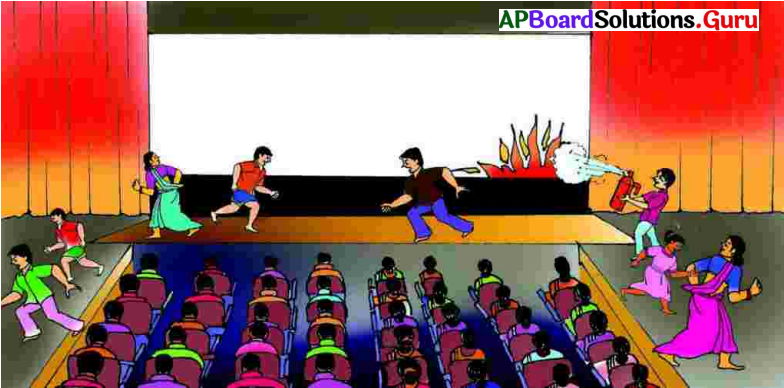
प्रश्न 1.
चित्र में क्या – क्या दिखाई दे रहे हैं? (చిత్రములో ఏమేమి కన్పించుచున్నవి?)
उत्तर:
चित्र में एक सिनेमा थियेटर (हाल) दिखाई दे रहा है। चाँदी का पर्दा दिखायी दे रहा है। दर्शक सिनेमा देखने कुर्सियों पर बैठे हुए हैं। अचानक चाँदी का पर्दा आग लगकर जल रहा है। कुछ लड़के दौडकर भाग रहे हैं। एक ओर से एक औरत और एक बच्ची भाग रही हैं। दो लडके और एक स्त्री पर्दे के सामने भाग रहे हैं। एक लडका तो अग्निशामक यंत्र पकडकर आग को बुझा रहा है।
(చిత్రంలో ఒక సినిమా హాలు (థియేటర్) కన్పించుచున్నది. వెండి తెర కన్పించుచున్నది. దర్శకులు (ప్రేక్షకులు) సినిమా చూచుట కొరకు కుర్చీలలో కూర్చుని ఉన్నారు. అకస్మాత్తుగా వెండితెర నిప్పు అంటుకుని తగలబడుచున్నది. కొంతమంది బాలురు పరుగెత్తి పారిపోవుచున్నారు. ఒకవైపున ఒక స్త్రీ మరియు ఒక బాలిక పరిగెత్తుచున్నారు. ఇద్దరు బాలురు మరియు ఒక స్త్రీ వెండితెర ముందు పరిగెత్తుచున్నారు. ఒక బాలుడు అగ్నిమాపక యంత్రమును పట్టుకుని మంటను ఆర్పుచున్నాడు.)
प्रश्न 2.
आग लगने पर लड़के ने क्या किया? (నిప్పు అంటుకున్నప్పుడు బాలుడు ఏమి చేసెను?)
उत्तर:
आग लगने पर लडके ने अग्निशामक यंत्र पकडकर आग को बुझाने का प्रयास किया।
(గుంట (నిప్పు) అంటుకున్నప్పుడు బాలుడు అగ్నిమాపక యంత్రమును పట్టుకుని మంటను ఆర్పుటుకు ప్రయత్నము చేసెను.)
![]()
साहसी बालक (సహస బాలుడు)

एक बालक था। वह चौथी कक्षा में पढ़ता था। उसका स्कूल गाँव से दूर था। वह प्रतिदिन पैदल चलकर स्कूल जाता था। रास्ते में नदी बहती थी। नाव से जाने के लिए उसके पास पैसे नहीं होते थे। वह रोज़ तैरकर ही स्कूल जाता था।
सर्दी के दिन थे। बालक स्कूल जाने के लिए नदी में कूद पडा। तैरते – तैरते नदी के बीच जा पहुँचा। उसी समय कुछ यात्री नाव पर सवार कर नदी पार कर रहे थे। उन्होंने सोचा कि बालक नदी में डूब जाएगा। वे अपनी नाव बालक के पास ले गए। उसे खींच कर नाव में बिठा लिया।
बालक के चेहरे पर कोई डर या घबराहट नहीं थी। सभी लोग चकित रह गए। इतना छोटा, इतना साहसी! वे बोले तू ! डूब मरोगे क्या ? कभी भी ऐसा साहस नहीं करना चाहिए।”
तब बालक बोला – “साहस करना ही पड़ता है जी, अब साहस नहीं करूँगा तो आगे चलकर मैं बड़े – बड़े काम कैसे कर सकूँगा? मैं रोज़ स्कूल नदी में तैरकर ही जाता हूँ।” लोग उसकी बात सुनकर दंग रह गये। यही साहसी बालक आगे चलकर भारत का प्रधानमंत्री बना। इन्हें सारा संसार लाल बहादुर शास्त्री के नाम से जानता है। इन्होंने ही देश को जय – जवान जय-किसान का नारा दिया।
పాఠ్య సారాంతం
ఒక బాలుడు ఉండెను. అతడు నాల్గవ తరగతి చదువుచుండెను. అతని పాఠశాల గ్రామమునకు చాలా దూరములో ఉండెను. అతడు ప్రతిరోజు నడిచే బడికి వెళ్ళేవాడు. దారిలో ఒక నది ప్రవహించేది. పడవలో వెళ్ళడానికి అతని వద్ద డబ్బులు ఉండేవి కావు. అతడు రోజూ నదిని ఈది బడికి వెళ్ళేవాడు.
చలికాలపు రోజులు. బాలుడు బడికి వెళ్ళుటకు నదిలో దూకెను. ఈదుతూ – ఈదుతూ నది మధ్యకు చేరెను. అదే సమయంలో కొంత మంది యాత్రికులు పడవలో నదిని దాటుచుండిరి. వారు ఈ పిల్లవాడు నదిలో మునిగిపోవునని భావించిరి. వారు తమ పడవను బాలుని వద్దకు తీసుకు వెళ్ళిరి. ఆ బాలుడిని లాగి నావలో కూర్చుండబెట్టిరి.
బాలుని ముఖంపై ఎటువంటి భయము కాని ఆందోళన కానీ కన్పించలేదు. ఇంత చిన్న పిల్లవాడు ఎంత సాహసికుడు అని. వారు ఆ బాలుడితో ఎప్పుడూ ఇలాంటి సాహసం చేయకు, మునిగి చనిపోతావా, ఏమిటీ ? అని అడిగిరి.
అప్పుడు బాలుడు ఈ విధంగా చెప్పెను – “సాహసం చేయవలసినదేనండి, ఇప్పుడు సాహసం చేయకపోతే ముందు – ముందు నేను పెద్ద పెద్ద పనులు ఎలా చేస్తాను? నేను రోజూ బడికి నది ఈదే వెళతాను”. వారందరూ ఆ మాట విని ఆశ్చర్యపోయిరి. ఈ సాహస బాలుడే ముందు ముందు భారత ప్రధానమంత్రి అయ్యెను. ఇతనిని ప్రపంచమంతా లాల్ బహాదుర్ అనే పేరుతో పిలుస్తోంది. ఈయనే జై జవాన్ – జై కిసాన్ అను నినాదం ఇచ్చేను.
Summary
Once there lived a boy. He was studying in 4th class. His school was very distant from his village. He used to go to school on foot every day. A river was flowing on the way. He had no money to go by a boat. Daily he used to go to school swimming across the river.
Those were winter days. The boy jumped into the river to go to school. He reached the middle of the river while swimming. At that very time some travellers were crossing the river by a boat. They thought that the bcy would drown in the river. They took their boat to the boy. They snatched him and seated him in the boat.
There was neither fear nor worry in the boy’s face. They were surprised. They exclaimed, “How brave this little kid is!”. They said to the boy, “Don’t ever do this kind of brave act. Would you like to die drowning in the river?”
Then the boy said to them, “I should certainly dare. If I don’t dare now, how can I manage big tasks in future ? I go to school every day crossing the river.” They were amazed to listen to his words. This is the very boy later became the Prime Minister of India. The whole world fondly calls him “Lal Bahadur”. This very person gave the slogan “Jai Javan – Jai Kisan”.
Intext Questions & Answers
प्रश्न 1.
शास्त्रीजी में साहस के अलावा और कौन कौन – से अच्छे गुण हैं? बताइए। (శాస్త్రిగారిలో సాహసమే కాక ఇంకా ఏమేమి మంచి గుణములు కలవు? తెలపండి.)
उत्तर:
लालबहादुर शास्त्री जी में साहस के अलावा निम्न लिखित अच्छे गुण हैं – आप स्वभाव से सादगी थे। आप उच्च विचार वाले व्यक्ति थे। आप शिष्टाचार के व्यक्ति थे| आप सच्चे और ईमानदार व्यक्ति थे।
(శాస్త్రిగారిలో సాహసమే కాక క్రింది పేర్కొనిన మంచి గుణములు కూడా కలవు. అవి – స్వభావత: వారు నిరాడంబర జీవితమును గడిపెను. ఉన్నత ఆలోచనలు కల్గిన వ్యక్తి. వారు మంచి సభ్యత, శిష్టాచారము కల్గిన వ్యక్తి. ఆయన నీతి, నిజాయితీ కల్గిన వ్యక్తి.)
![]()
प्रश्न 2.
अगर तुम बालक की जगह पर होते तो क्या करते? (ఒకవేళ నీవు బాలుని స్థానంలో ఉంటే ఏమి చేస్తావు?)
उत्तर:
अगर मैं बालक की जगह पर होता तो मैं भी स्कूल हर दिन पैदल जाता/जाती। मैं भी स्कूल नदी में तैरकर जाता / जाती मैं साहस एवं धैर्य के साथ रहता / रहती।
(ఒకవేళ నేను బాలుడి స్థానములో ఉన్నట్లయితే నేను కూడా బడికి కాలి నడకనే వెళతాను. నేను కూడా బడికి నదిలో ఈది వెళతాను. నేను సాహసంతో, ధైర్యంతో ఉంటాను.)
Improve Your Learning
सुनिए-बोलिए
प्रश्न 1.
कुछ साहसी बालकों या बालिकाओं के नाम बताइए। (కొంతమంది సాహస బాలురు లేదా బాలికల పేర్లు తెల్పండి.)
उत्तर:
पूर्णचंद्र, गोविंदन, रितिक साहु, कुंवर दिव्यांश सिंह,लमगांव सिंह, मंदीप कुमार पाठक आदि कुछ साहसी बालक थे।
(పూర్ణ్ చంద్, గోవిందన్, రితిక్ సాహు, కుంవర్ దివ్యాంశ్ సింహ్, లంగావ్ సింహ్, మందీప్ కుమార్ పాఠక్ మొదలగువారు సాహస బాలుడు.)
प्रश्न 2.
आप स्कूल कैसे आते हैं? (మీరు బడికి ఎలా వస్తారు?)
उत्तर:
मैं स्कूल पिताजी के स्कूटर पर आता/आती हूँ।
(నేను బడికి నాన్నగారి స్కూటర్ పై వస్తాను.)
![]()
प्रश्न 3.
आँध्रप्रदेश की प्रमुख नदियों के नाम बताइए। (ఆంధ్రప్రదేశ్ లోని ప్రముఖ నదుల పేర్లు తెలపండి.)
उत्तर:
आंध्रप्रदेश की प्रमुख नदियाँ कृष्णा नदी और गोदावरी नदी हैं। गोदावरी नदी को दक्षिणी गंगा भी कहते हैं। इनके अलावा पेन्ना, स्वर्णमुखी, मुन्नेरु और चित्रावती आदि नदियाँ भी हैं।
(ఆంధ్రప్రదేశ్ లోని ప్రముఖ నదులు కృష్ణానది మరియు గోదావరి నది. గోదావరి నదిని దక్షిణీ గంగా అని కూడా పిలిచెదరు. ఇవేకాకుండా పెన్నా, స్వర్ణముఖి, మున్నేరు మరియు చిత్రావతి మొదలగు నదులు కూడా కలవు.
पढ़िए
अ) जोड़ी बनाइए।
| 1. नदी | बहती थी। |
| 2. बालक | चौथी कक्षा में पढ़ता था। |
| 3. स्कूल | गाँव से दूर था। |
| 4. लोग | उसकी बातों से दंग रह गये। |
| 5. लाल बहादुर शास्त्री ने | जय जवान – जय किसान का नारा दिया। |

आ) पाठ में वाक्यों के सही क्रम को पहचानकर क्रम संख्या कोष्ठक में लिखिए।
1. तैरते – तैरते नदी के बीच आ पहुंचा। [ 2 ]
2. एक बालक चौथी कक्षा में पढ़ता था। [ 1 ]
3. ऐसा साहस नहीं करना चाहिए। [ 5 ]
4. इतना छोटा इतना साहसी। [ 3 ]
5. लोग उसकी बातों से दंग रह गए। [ 4 ]
इ) सही वर्तनी वाले शब्दों पर गोला “O” बनाइए।
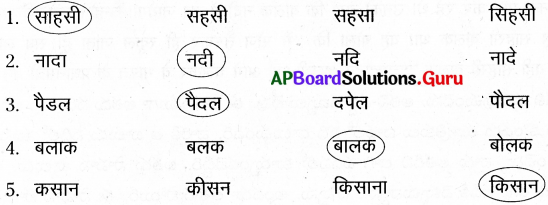
ई) चित्रों से संबंधित शब्दों पर गोला “O” बनाइए।
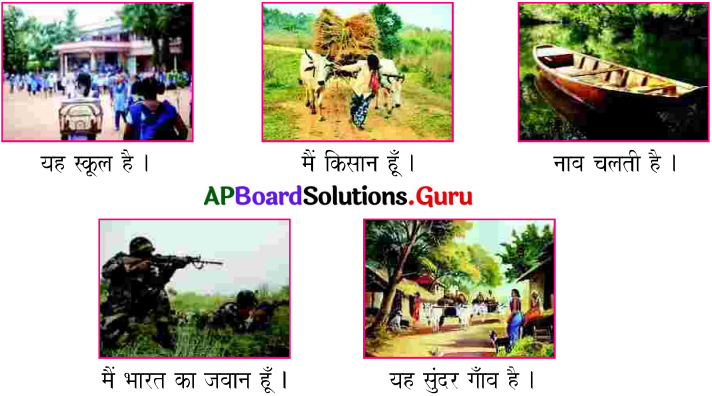
उत्तर:
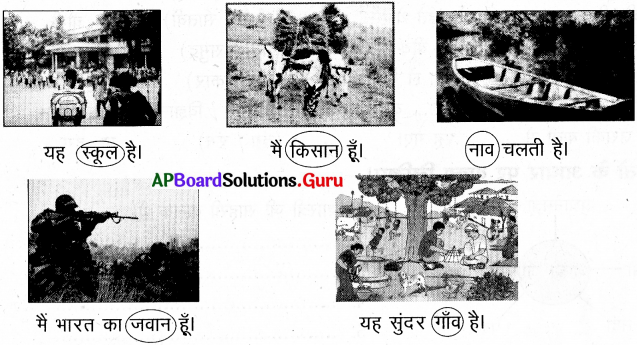
लिखिए
अ) नीचे दिये गये प्रश्नों के उत्तर छोटे – छोटे वाक्यों में लिखिए।
క్రింది ఇవ్వబడిన ప్రశ్నలకు సమాధానములు చిన్న – చిన్న వాక్యములలో ఇవ్వండి.
1. शास्त्री जी स्कूल कैसे जाते थे? (శాస్రిగారు పాఠశాలకు ఎలా వెళ్ళేవారు?)
उत्तर:
शास्त्री जी प्रतिदिन पैदल चलकर स्कूल जाते थे। वे रोज नदी तैरकर स्कूल जाते थे।
(శాస్రిగారు ప్రతిరోజు కాలి నడకన పాఠశాలకు వెళ్ళేవారు. ఆయన ప్రతిరోజూ నదిని ఈదుకుని బడికి వెళ్ళేవారు.)
2. लालबहादुर शास्त्री जी ने देश को कौन – सा नारा दिया? (లాల్ బహాదుర్ శాస్త్రిగారు దేశానికి ఏమి నినాదము ఇచ్చిరి?)
उत्तर:
लालबहादुर शास्त्री जी ने देश को ‘जय – जवान जय – किसान का नारा दिया।
(లాల్ బహాదుర్ శాస్త్రిగారు దేశానికి “జై – జవాన్ జై – కిసాన్” అను నినాదమును ఇచ్చిరి.)
![]()
आ) नीचे दिये गये प्रश्न का उत्तर पाँच – छह वाक्यों में लिखिए।
క్రింది ఇవ్వబడిన ప్రశ్నకు సమాధానము 5 -6 వాక్యములలో వ్రాయండి.
“साहसी बालक” पाट का सारांश अपने शब्दों में लिखिए। (‘సాహసీ బాలక్’ పాఠము సారాంశమును మీ మాటల్లో వ్రాయండి.)
उत्तर:
एक बालक चौथी कक्षा में पढ़ता था। उसके पास पैसे नहीं थे। इस कारण वह नदी में तैरकर स्कूल जाता था। एक बार कुछ यात्री नाव में नदी पार कर रहे थे। उनको लगा कि बालक नदी में डूब जायेगा। उन्होंने उसे खींचकर नाव में बिठा लिया। वह साहसी बालक था। वह बोला कि “मैं रोज़ तैरकर ही स्कूल जाता हूँ। सब लोग आश्चर्यचकित रह गये। यही साहसी बालक लालबहादुर शास्त्री था। आगे चलकर वे भारत के प्रधानमंत्री बने।
(ఒక బాలుడు 4వ తరగతి చదువుచుండెను. అతని వద్ద డబ్బులు లేవు. ఈ కారణముగా అతడు నది ఈది బడికి వెళ్ళుచుండెను. ఒకసారి కొందరు యాత్రికులు నావలో నది దాటుచుండిరి. వారికి ఆ బాలుడు నదిలో మునిగి పోతున్నాడు అని అనిపించెను. వారు అతడిని లాగి పడవలో కూర్చుండబెట్టిరి. అతడు సాహస బాలుడు. ఆ బాలుడు నేను రోజూ నది ఈది బడికి వెళ్ళుచున్నానని చెప్పెను. అందరూ ఆశ్చర్యపోయిరి. ఈ సాహస బాలుడే లాల్ బహాదుర్ శాస్త్రి. ముందు ముందు ఆయన భారతదేశ ప్రధానమంత్రి అయ్యెను.)
इ) उचित शब्दों से खाली जगह भरिए।
1. शास्त्री जी ………… कक्षा में पढ़ते थे। (चौथी | सातवीं)
उत्तर:
चौथी
2. बालक तैरते – तैरते ………. के बीच आ पहुँचा। (नदी / समुद्र)
उत्तर:
नदी
3. यात्री ………. को बालक के पास ले गए। (नाव | कार)
उत्तर:
नाव
4. उन्होंने जय – जवान जय – ………. का नारा दिया। (किसान / विज्ञान)
उत्तर:
किसान
5. लोग उसकी बातों से ……… रह गए। (दंग / रंग)
उत्तर:
दंग
![]()
ई) संकेतों के आधार पर वाक्य लिखिए।
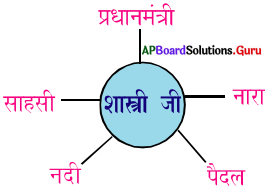
1. शास्त्री जी साहसी बालक थे।
उत्तर:
1. शास्त्री जी साहसी बालक थे।
2. शास्त्री जी हर दिन स्कूल नदी में तैरकर जाते थे।
3. शास्त्री जी हर दिन स्कूल पैदल जाते थे।
4. शास्त्री जी भारत के प्रधानमंत्री बने थे।
5. जय – जवान जय – किसान शास्त्रीजी का नारा है।
उ) वर्ण विच्छेद कीजिए।
1. पैदल : प + ऐ + द् + अ + ल् + अ
2. खींचना : ……………………………
3. रास्ता : ……………………………..
4. शास्त्री : ……………………….
5. प्रधानमंत्री : …………………..
उत्तर:
1. पैदल : प + ऐ + द् + अ + ल् + अ
2. खींचना : ख् + ई + च् + अ + न् + आ
3. रास्ता : र + आ + स् + त् + आ
4. शास्त्री : श् + आ + स् + त् + र् + ई
5. प्रधानमंत्री प् + र् + अ + ध् + आ + न् + अ + म् + अं + त् + र् + ई
भाषांश
अ) अंत्याक्षरी विधि के अनुसार नीचे दिये गये शब्दों के चार शब्द लिखिए।
1. स्कूल – लड़का – काम – मन – नल
2. बालक – ……………………….
उत्तर:
कोयल, लगन, नारा, रामायण
3. नाव – …………………………….
उत्तर:
वज़न, नानी, नीला, लपक
4. भारत – ………………………..
उत्तर:
तरल, लता, ताल, लाज
5. किसान – ……………………
उत्तर:
नायक, किसान, नाटक, कप
![]()
आ) पर्यायवाची शब्द लिखिए।
1. गाँव – ग्राम, देहात
2. स्कूल – ……………….
उत्तर:
विद्यालय, पाठशाला
3. नदी – …………………….
उत्तर:
नद, सरिता
4. डर – …………………………..
उत्तर:
भय, त्रास
5. साहसी – ………………….
उत्तर:
हिम्मती, दिलेर
इ) विलोम शब्द लिखिए।
1. एक × अनेक
2. गॉव शहर
3. देश × विदेश
4. दूर × पास
5. छोटा × बड़ा
सृजनात्मकता
अ) चित्र देखकर दो वाक्य लिखिए।

उत्तर:
1. इस चित्र में अल्लूरि सीताराम राजू है।
2. अल्लूरि सीताराम राजू का जन्म विशाखपट्टणम जिले में हुआ।
3. वह एक वीर योद्धा थे।
4. अल्लूरि सीताराम राजू ने अंग्रेजों के विरुद्ध लडाई की थी।
5. अल्लूरि सीताराम राजू पुलीस थाने पर आक्रमण करते थे।
आ) परियोजना कार्य :
महान् व्यक्तियों के नारों को संग्रहित करके चार्ट पर लिखिए।
(గొప్ప వ్యక్తుల నినాదములను సంగ్రహించి చార్టుపై వ్రాయండి.)
उत्तर:
1. “स्वराज्य हमारा जन्म सिद्ध अधिकार है।” – बालगंगाधर तिलक
2. तुम मुझे खून दो मैं तुम्हें आजादी दूंगा। – सुभाष चंद्रबोस
3. सारे जहाँ से अच्छा हिंदोस्ताँ हमारा – अल्लामा इकबाल
4. इन्कलाब जिंदाबाद – भगत सिंह
5. करो या मरो – महात्मा गाँधी
6. जय हिंद – सुभाष चंद्रबोस
7. पूर्ण स्वराज्य – जवाहर लाल नेहरू
8. जय – जवान जय – किसान – लालबहादुर शास्त्री
9. वंदेमातरम – बकिंगचंद्र चटर्जी
10. कर मत दो – वल्लभाई पटेल
11. आत्म निर्भर भारत – नरेंद्र मोदी
![]()
इ) अनुवाद कीजिए।
1. मैं सातवीं कक्षा में पढ़ता हूँ।
उत्तर:
मैं सातवीं कक्षा में पढ़ता हूँ। నేను ఏడవ తరగతిలో చదువుతాను.
2. भारत बहु भाषी देश है।
उत्तर:
भारत बहु भाषी देश है। భారతదేశము బహుభాషలు మాట్లాడు దేశము.
3. गंगा नदी बहती है।
उत्तर:
गंगा नदी बहती है। గంగానది ప్రవహించును.
4. वह होशियार बालक है।
उत्तर:
वह होशियार बालक है। అతడు తెలివి గల బాలుడు.
5. तैराक ने सभी लोगों को बचाया।
उत्तर:
तैराक ने सभी लोगों को बचाया। ఈతగాడు ప్రజలందరినీ రక్షించెను.
व्याकरणांश
उदा : 1. मैं साहसी हूँ। 2. गाँव में छोटी सी दूकान है। 3. यह लाल सेब है।
परिभाषा : संज्ञा या सर्वनाम की विशेषता बतानेवाले शब्दों को ‘विशेषण’ कहते हैं।
जैसे छोटा, बड़ा, सुंदर, साहसी, बुद्धिमान, मीठा, कम आदि।
(నామవాచకము (సంజ్ఞ) లేక సర్వనామము యొక్క విశేషతలను తెలియజేయు శబ్దాలను విశేషణం అని అంటారు.)
अ) निम्न लिखित वाक्यों में विशेषण शब्द को रेखांकित कीजिए।
1. गुलाब सुंदर होता है।
2. आम मीठा होता है।
उत्तर:
आम मीठा होता है।
3. वह अच्छा लड़का है।
उत्तर:
वह अच्छा लड़का है।
4. गंगा पवित्र नदी है।
उत्तर:
गंगा पवित्र नदी है।
5. मुझे गरम पानी दीजिए।
उत्तर:
मुझे गरम पानी दीजिए।
![]()
आ) निम्र विशेषण शब्दों को अपने वाक्यों में प्रयोग कीजिए।
1. नीला – आसमान नीला है।
2. मोटा – ……………….
उत्तर:
गोपाल मोटा आदमी है।
3. लाल – ……………
उत्तर:
लाल किला दिल्ली में है।
4. ऊँचा – ………………
उत्तर:
ऊँट ऊँचा जानवर है।
5. मीठा – ……………….
उत्तर:
मिठाई बहुत मीठी है।
अध्यापकों के लिए सूचना : ఉపాధ్యాయులకు సూచన :
→ साहसी बालकों के साहस कार्यों के बारे में कक्षा में चर्चा कीजिए।
(సాహస బాలుర సాహస కార్యాలను గురించి తరగతి గదిలో చర్చించండి.)
उत्तर:
साहस कार्य : छत्तीसगढ़ के दुर्ग जिले में मज़दूरी कर अपने परिवार का लालन – पालन करनेवाले 17 वर्षीय मुकेश निषाद ने अनाज घर में छः बच्चों की जान बचाई। भटगाँव नामक ग्राम में एक अनाज घर में आग लग गयी। जिसमें विभिन्न परिवार के छः बच्चे गिर गये। भीषण आग से धुंआ भर गया। सभी बच्चे घुटन महसूस करने लगे। सभी बच्चे रोने चिल्लाने लगे। उनकी हालत देख मुकेश अपनी जान जोखिम में डालते हुए आग लगे घर में घुसा और एक – एक कर सभी बच्चों को बाहर निकाल दिया। उसके परिवार में दो भाई और माँ है। सात साल पहले उसके पिता का निधन हो गया। पिछले दस साल से वह चावल मिल में काम कर रहा था। माँ स्कूल में चपरासी है। मुकेश सत्रह साल का लड़का है। उसे गणतंत्र दिवस के अवसर पर राष्ट्रीय वीरता पुरस्कार प्राप्त हुआ।
पाठ का सारांश
एक बालक चौथी कक्षा में पढ़ता था। उसके पास पैसे नहीं थे। इस कारण वह नदी में तैरकर स्कूल जाता था। एक बार कुछ यात्री नाव में नदी पार कर रहे थे। उनको लगा कि बालक नदी में डूब जायेगा। उन्होंने उसे खींचकर नाव में बिठा लिया। वह साहसी बालक था। वह बोला कि “मैं रोज तैर कर ही स्कूल जाता हूँ। सब लोग आश्चर्यचकित रह गये। यही साहसी बालक लालबहादुर शास्त्री था। आगे चलकर वे भारत के प्रधानमंत्री बने।
పాఠ్య సారాంశం
ఒక బాలుడు 4వ తరగతి చదువుచున్నాడు. అతని వద్ద డబ్బులు లేవు. ఈ కారణముగా అతడు నది ఈది బడికి వెళ్ళుచుండెను. ఒకసారి కొందరు యాత్రికులు నావలో నది దాటుచుండిరి. వారికి ఆ బాలుడు నదిలో మునిగిపోతున్నాడు అని అనిపించెను. వారు అతడిని లాగి పడవలో కూర్చుండబెట్టిరి. అతడు సాహస బాలుడు. ఆ బాలుడు నేను రోజూ నది ఈది బడికి వెళ్ళుచున్నానని చెప్పెను. అందరూ ఆశ్చర్యపోయిరి. ఈ సాహస బాలుడే లాల్ బహాదుర్ శాస్త్రి ముందు ముందు ఆయన భారతదేశ ప్రధానమంత్రి అయ్యెను.
Summary
A boy was studying in 4th class. He had no money. So, he used to go to school swimming across the river. Once some travellers were crossing the river by a boat. They thought that the boy was drowning in the river. They snatched him and seated him in the boat. He was a brave boy. He said that he goes to school every day swimming across the river. They were amazed. This brave boy was none other than Lal Bahadur Sastri who later became the Prime Minister of India.
व्याकरणांश (వ్యాకరణాంశాలు)
लिंग बदलिए (లింగములను మార్చండి)
बालक – बालिका
देवर – देवरानी
सदस्य – सदस्या
सेवक – सेविका
भिखारी – भिखारिन
भक्त – भक्तिन
मालिक – मालिकिन
माली – मालिन
महोदय – महोदया
अध्यक्ष – अध्यक्षा
नायक – नायिका
नेता – नेत्री
वचन बदलिए (వచనములను మార్చండి)
बच्चा – बच्चे
लडका – लडके
रास्ता – रास्ते
पैसा – पैसे
स्कूल – स्कूल
नदी – नदियाँ
यात्री – यात्रियाँ
नाव – नाव
काम – काम
संसार – संसार
नाम – नाम
देश – देश
विलोम शब्द (వ్యతిరేక పదములు)
डर × निड़र
साहसी × डरपोक
विजय × अपजय
धैर्य × अधैर्य
बचपन × बुढ़ापा
आगे × पीछे
प्रसिद्ध × अप्रसिद्ध
दूर × पास
गाँव × शहर
प्रतिदिन × कभी – कभी
सर्दी × गर्मी
छोटा × बड़ा
![]()
शब्दार्थ (అర్థాలు) (Meanings)
स्कूल = पाठशाला, పాఠశాల, school
साहस = हिम्मत, ధైర్యము, dare
दंग रह जाना = आश्चर्यचकित होना, ఆశ్చర్యపోవుట, stunned
गाँव = ग्राम, గ్రామము, village
संसार = दुनिया, ప్రపంచము, the world
प्रतिदिन = हर रोज, ప్రతిరోజూ, everyday
बालक = लडका, బాలుడు, a boy
कक्षा = वर्ग, తరగతి, class
नाव = नौका, నావ, పడవ, boat
सर्दी = शीतलता, చలి, cold
लोग = जनता, ప్రజలు, people
बहादुर = वीर, వీరుడు, brave
किसान = कृषक, రైతు, farmer
जवान = सिपाही, సిపాయి, soldier
देश = राष्ट्र, దేశము, country
नारा = आवाज़, నినాదము, slogan
श्रुत लेख : శ్రుతలేఖనము : Dictation
अध्यापक या अध्यापिका निम्न लिखित शब्दों को श्रुत लेख के रूप में लिखवायें। छात्र अपनी – अपनी नोट पुस्तकों में लिखेंगे। अध्यापक या अध्यापिका इन्हें जाँचे।
ఉపాధ్యాయుడు లేదా ఉపాధ్యాయిని క్రింద వ్రాయబడిన శబ్దములను శ్రుతలేఖనంగా డిక్టేట్ చేయును. విద్యార్థులు వారి వారి నోట్ పుస్తకాలలో వ్రాసెదరు. ఉపాధ్యాయుడు లేదా ఉపాధ్యాయిని వాటిని దిద్దెదరు.

